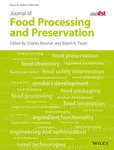Extraction of essential oils from Kumquat peel using ultrasound-assisted vacuum hydrodistillation
Funding information: This study was funded by the National Natural Science Foundation of China (81560657, 81903929), China; Jiangxi Province Education Department of Science and Technology Project (GJJ180677), China; Jiangxi Province; Key Research and Development Program (20192BBG70072), China; Jiangxi university of traditional Chinese medicine 1050 youth talent project (No grant number), China; Jiangxi University of Chinese Medicine Innovation Training Program for College Students in 2021 (202110412203), China.
Abstract
In the current study, ultrasound-assisted vacuum extraction (UAVE) was applied to improve the efficiency of hydrodistillation extraction (HDE) and vacuum hydrodistillation extraction (VHE) and produce Kumquat peel essential oil (EO) with acceptable quality. To achieve these objectives, the effects of ultrasound power (210–300 W), ultrasound time (15–40 min), and pressure (600–900 mbar) were evaluated. Results showed that the EO yield initially increased and then decreased with increasing ultrasound power, ultrasound time, and pressure, and the highest EO yield was achieved at 270 W, 20 min, and 800 mbar. The EO obtained by UAVE under conditions allowed a higher EO yield than VHE and less extraction time than HDE, and provided EO with higher antioxidant activity due to differences in chemical composition. Overall, the application of UAVE could be an effective approach to improve the extraction efficiency and quality of the Kumquat peel EO.
Novelty impact statement
- Ultrasound-assisted vacuum hydrodistillation was applied to extract essential oil (EO).
- A comparative study on the ultrasound-assisted vacuum hydrodistillation extraction.
- Ultrasound-assisted vacuum hydrodistillation improved the antioxidant activity of EO.
CONFLICT OF INTEREST
The authors have declared no conflicts of interest for this article .
Open Research
DATA AVAILABILITY STATEMENT
Research data are not shared.




